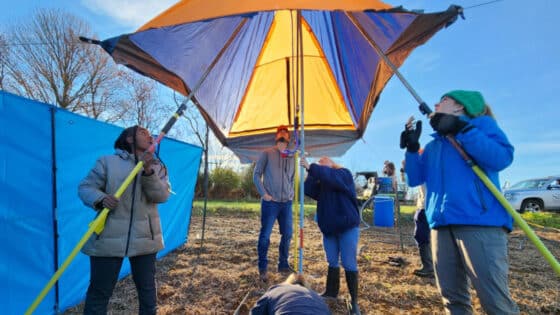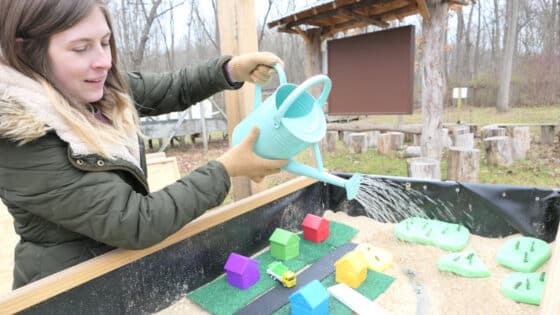Peer-reviewed publication of our research, education, and restoration activities is a fundamental tool for all staff at Stroud Water Research Center. This process often represents years of hard work, collaboration, and interacting with our peers throughout the world.
The articles below represent the pinnacle of our annual effort to communicate our research and education findings to our respective peer-communities. Many of these articles are published online via professional society journals and are available throughout the world at libraries and institutions of higher education.
ARTICLE ABSTRACTS, AND IN SOME CASES, COMPLETE ARTICLES CAN BE ACCESSED BY CLICKING THE DOI LINKS. IF AN ARTICLE IS NOT AVAILABLE ONLINE, YOU MAY EMAIL THE AUTHOR DIRECTLY TO REQUEST A COPY.
- Albertson, L. K., and D. C. Allen. 2014. Meta-analysis: Abundance, behavior, and hydraulic energy shape biotic effects on sediment transport in streams. Ecology. DOI: 10.1890/13-2138.1
- Bengtsson, M.M., K. Wagner, N.R. Burns, E.R. Herberg, W. Wanek, L.A. Kaplan, and T.J. Battin. 2014. No evidence of aquatic priming effects in hyporheic zone microcosms. Scientific Reports, DOI:10.1038/srep05187
- Burchsted, D., and M.D. Daniels. 2014. Classification of the alterations of beaver dams to headwater streams in northeastern Connecticut, U.S.A. Geomorphology, 205:36-50. DOI:10.1016/j.geomorph.2012.12.029
- Burchsted, D., M. Daniels, E.E. Wohl. 2014. Introduction to the special issue on discontinuity of fluvial systems. Geomorphology, 205:1-4. DOI: 10.1016/j.geomorph.2013.04.004
- Camp, A.A., D.H. Funk, and D.B. Buchwalter. 2014. A stressful shortness of breath: molting disrupts breathing in the mayfly Cloeon dipterum. Freshwater Science, 33(3):695-699. DOI: 10.1086/677899
- Chin, A., L. R. Laurencio, M.D. Daniels, E. Wohl, M.A. Urban, K.L. Boyer, A. Butt, H. Piegay, K.J. Gregory. 2014. The significance of perceptions and feedbacks for effectively managing wood in rivers. River Research and Applications, 30(1): 98-111. DOI: 10.1002/rra.2617
- Costigan, K.H., C.M. Ruffing, J.S. Perkin, and M.D. Daniels. 2014. Rapid response of a sand-dominated river to installation and removal of a temporary run-of-the-river dam. River Research and Applications. DOI:10.1002/rra.2843
- Costigan, K.H., M.D. Daniels, J.S. Perkin, and K.B. Gido. 2014. Longitudinal variability in hydraulic geometry and substrate characteristics of a Great Plains sand-bed river. Geomorphology, 210:48-58. DOI:10.1016/j.geomorph.2013.12.017
- Feng, W., A.F. Plante, A.K. Aufdenkampe, J. Six. 2014. Soil organic matter stability in organo-mineral complexes as a function of increasing C loading. Soil Biology and Biochemistry, 69:398-405. DOI:10.1016/j.soilbio.2013.11.024
- Gallardo, B., S. Dolédec, A. Paillex, D.B. Arscott, F.Sheldon, F. Zilli, S. Mérigoux, E. Castella, and F.A. Comín. 2014. Response of benthic macroinvertebrates to gradients in hydrological connectivity: a comparison of temperate, subtropical, Mediterranean and semiarid river floodplains. Freshwater Biology, 59:630-648. DOI: 10.1111/fwb.12292
- Gill, S.E., N. Marcum-Dietrich and R. Becker-Klein. 2014. Model My Watershed: Connecting Students’ Conceptual Understanding of Watersheds to Real-World Decision Making. Journal of Geoscience Education, 62(1):61-73. DOI: 10.5408/12-395.1
- Hong, Y., X. Xu, J. Kan, F. Chen. Linking seasonal inorganic nitrogen shift to the dynamics of microbial communities in the Chesapeake Bay. Applied Microbiology and Biotechnology, 98 (7):3219-3229. DOI: 10.1007/s00253-013-5337-4
- Jackson, J.K., J. M. Battle, B.P. White, E.M. Pilgrim, E.D. Stein, P. E. Miller, and B.W. Sweeney. 2014. Cryptic biodiversity in streams: a comparison of macroinvertebrate communities based on morphological and DNA barcode identifications. Freshwater Science, 33(1):312-324. DOI: 10.1086/675225
- Johnson, B.R., P.C. Weaver, C.T. Nietch, J.M. Lazorchak, K.A. Struewing, and D.H. Funk. 2014. Elevated major ion concentrations inhibit larval mayfly growth and development. Environmental Toxicology and Chemistry. DOI: 10.1002/etc.2777
- Lyttle, A. , K. Yoo, C. Hale, A. Aufdenkampe, S.D. Sebestyen, K. Resner, A. Blum. 2014. Impact of exotic earthworms on organic carbon sorption on mineral surfaces and soil carbon inventories in a northern hardwood forest. Ecosystems. DOI: 10.1007/s10021-014-9809-x
- Mei, Y., G.M. Hornberger, L.A. Kaplan, J.D. Newbold, and A.K. Aufdenkampe. 2014. The delivery of dissolved organic carbon from a forested hillslope to a headwater stream in southeastern Pennsylvania, USA, Water Resources Research. DOI: 10.1002/2014WR015635
- Mosher, J.J., B. Bowman, E.L. Bernberg, O. Shevchenko, J. Kan, J. Korlach, and L.A. Kaplan. 2014. Improved performance of the PacBio SMRT technology for 16S rDNA sequencing. Journal of Microbiological Methods, 104:59–60. DOI: 10.1016/j.mimet.2014.06.012
- Perkin, J.S., K.B. Gido, K.H. Costigan, M.D. Daniels, and E. Johnson. 2014. Fragmentation and drying ratchet down Great Plains stream fish diversity. Aquatic Conservation: Marine and Freshwater Ecosystems. DOI: 10.1002/aqc.2501
- Resner, K., K. Yoo, S.D. Sebestyen, A. Aufdenkampe, C. Hale, A. Lyttle, A. Blum 2014. Invasive earthworms deplete key soil inorganic nutrients (Ca, Mg, K, and P) in a northern hardwood forest. Ecosystems, DOI: 10.1007/s10021-014-9814-0
- Richardson, D.C., I.A. Oleksy, T.J. Hoellein, D.B. Arscott, C.A. Gibson, S.M. Root. 2014. Habitat characteristics, temporal variability, and macroinvertebrate communities associated with a mat-forming nuisance diatom (Didymosphenia geminata) in Catskill mountain streams, New York. Aquatic Sciences, 76 (4):553-564. DOI: 10.1007/s00027-014-0354-7
- Sawyer, A.H., L.A. Kaplan, O. Lazareva, and H.A. Michael. 2014. Hydrologic dynamics and geochemical responses within a floodplain aquifer and hyporheic zone during Hurricane Sandy. Water Resources Research, 50 (6):4877–4892. DOI: 10.1002/2013WR015101
- Sleighter, R.L., R.M. Cory, L.A. Kaplan, H.A.N. Abdulla, and P.G. Hatcher. 2014. A coupled geochemical and biogeochemical approach to characterize the bioreactivity of dissolved organic matter from a headwater stream. Journal of Geophysical Research: Biogeosciences, 119 (8):1520-1537. DOI: 10.1002/2013JG002600
- Stein E.D., B.P. White, R.D. Mazor, J.K. Jackson, J.M. Battle, P.E. Miller, E.M. Pilgrim, and B.W. Sweeney. 2014. Does DNA barcoding improve performance of traditional stream bioassessment metrics? Freshwater Science, 33(1):302-311. DOI: 10.1086/674782
- Struewing, K.A. , J.M. Lazorchak, P.C. Weaver, B.R. Johnson, D.H. Funk, D.B. Buchwalter. 2014. Part 2: Sensitivity comparisons of the mayfly Centroptilum triangulifer to Ceriodaphnia dubia and Daphnia magna using standard reference toxicants; NaCl, KCl and CuSO4. Chemosphere. DOI: 10.1016/j.chemosphere.2014.04.096
- Sweeney, B.W. and J.D. Newbold. 2014. Streamside Forest Buffer Width Needed to Protect Stream Water Quality, Habitat, and Organisms: A Literature Review. Journal of the American Water Resources Association, 50:560-584. DOI: 10.1111/jawr.12203
- Tsang, Y., G. M. Hornberger, L. A. Kaplan, J. D. Newbold, and A. K. Aufdenkampe. 2014. A variable source area for groundwater evapotranspiration: impacts on modeling stream flow. Hydrological Processes, 28: 2439-2450. DOI: 10.1002/hyp.9811
- Walker, T.J., and D.H. Funk. 2014. Systematics and Acoustics of North American Anaxipha (Gryllidae: Trigonidiinae). Journal of Orthoptera Research, 23:1-38. DOI: 10.1665/034.023.0102
- Weaver, P.C., J.M. Lazorchak, K.A. Struewing, S.J. DeCelles, D.H. Funk, D.B. Buchwalter, B.R. Johnson. 2014. Part 1: Laboratory culture of Centroptilum triangulifer (Ephemeroptera: Baetidae) using a defined diet of three diatoms. Chemosphere. DOI: 10.1016/j.chemosphere.2014.04.092



